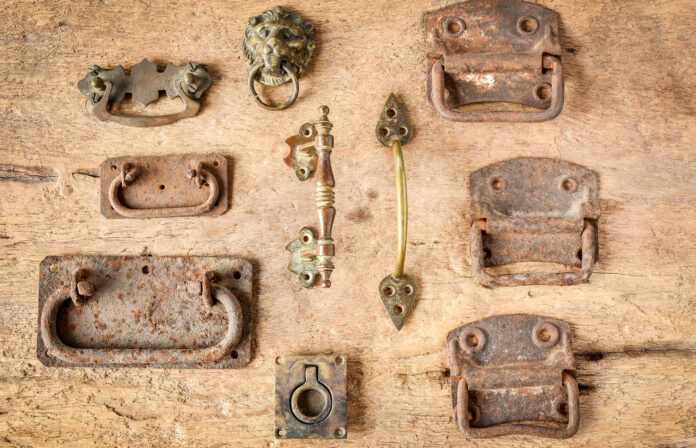
Antique hardware, symbolizing artistry from the days of yore, showcases meticulous designs and historical depth. These pieces, ranging from the ornate door handles reminiscent of Renaissance artistry to simple yet stately rustic hinges, serve dual purposes.
They not only elevate the aesthetic allure of homes and curated collections but also encapsulate tales of bygone epochs, relaying the ambiance and essence of their times. As demand surges, so does the flood of reproductions and faux antiques in the market.
This burgeoning trend underscores the need to meticulously discern genuine pieces from clever facsimiles, which is an intricate blend of both art and science.
Why Authentication Matters
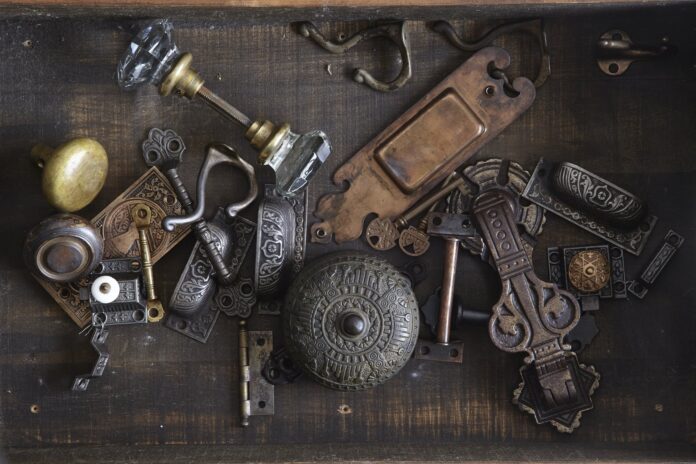
At a casual glance, reproductions might exude an allure mirroring that of the originals, deceiving the layman. Yet, for connoisseurs, collectors, and discerning buyers, the difference is not just crucial; it’s everything.
Genuine antique hardware, given its rarity and historical essence, can fetch significant monetary returns, transcending its mere ornamental value to become a worthy investment. Reproductions, despite being artfully crafted, can’t match the intrinsic and monetary worth of original antiques.
Beyond monetary considerations, each genuine antique piece is an emblem of its epoch, mirroring its artistic trends, technological strides, and the societal nuances of its age. Mislabeling replicas as authentic not only jeopardizes financial investments but also distorts our historical comprehension.
Research and Documentation
Embarking on the quest to buy restoration hardware without exhaustive research is akin to exploring unknown territories blindfolded. The path to authenticating these treasured pieces mandates a solid grounding in their historical backdrop.
Ancient texts, vintage catalogues, and invaluable museum references emerge as guiding stars in this journey. Proper documentation is a touchstone of authenticity. The provenance, or the detailed lineage of the item, when accessible, becomes an unerring tool.
Ancillary evidence like dated records, past ownership trails, or even timeworn photographs, further accentuates the piece’s authenticity, weaving a tapestry of its journey through time.
Materials and Manufacturing Techniques

An excavation into bygone materials and craftsmanship methodologies offers a window into the past. In epochs preceding the Industrial Revolution, artisans painstakingly handcrafted hardware, infusing each piece with unique quirks.
Metals like brass, iron, and bronze reigned supreme, with their aging processes bequeathing them distinct patinas. Comprehending the production techniques endemic to specific eras, be it the intricacies of sand casting or the nuances of hand forging, amplifies the authentication process.
Subtle marks and imprints borne from these methods, often overlooked by novices, become beacon indicators of the item’s genesis and age.
Identifying Antique Hardware Types
The realm of antique hardware is a vast tapestry, with diverse threads weaving tales of varied epochs. From the exquisite Victorian door knobs dripping with elegance to the utilitarian hinges emblematic of early colonial craftsmanship, the spectrum is wide and wondrous.
The flamboyant Rococo designs, with their intricate flourishes, offer a stark aesthetic contrast to the minimalist, purpose-driven artifacts of early American colonial days. Recognizing these distinctive elements holds the key to accurate identification.
Maker’s Marks and Signatures
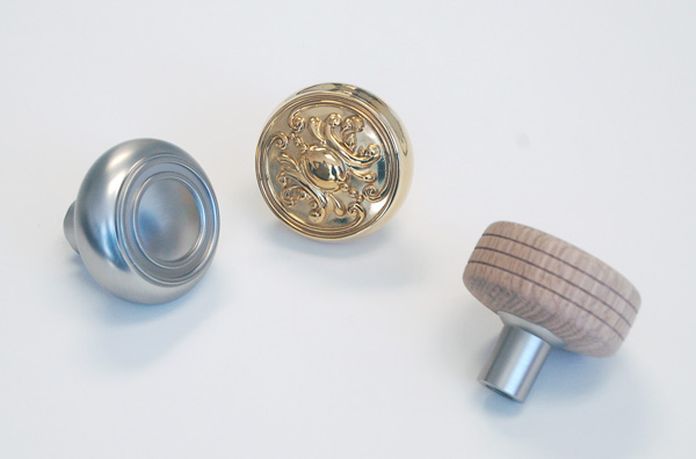
The dedicated artisans of yesteryears, deeply engrossed in their craft and brimming with pride, frequently chose to leave distinct imprints on their creations. These symbolic marks, reflective of their mastery, encompassed a wide range – from subtly cryptic initials and emblematic symbols to intricately designed logos and signatures.
Diving deep into meticulous research of these markings can act as an invaluable compass, guiding enthusiasts through the vast ocean of antique hardware. Beyond merely affirming authenticity, these markings often unveil stories; they offer glimpses into an item’s unique origins, hinting at its historical context, and occasionally revealing the identity of the master craftsmen behind them.
Patents and Date Codes
Lurking within the heart of many antiques lie markers of their age and innovation – the invaluable patents and cryptic date codes. These imprints, whether faintly etched or more prominently stamped, act as windows, opening to reveal insights into the item’s specific production timeline.
To the untrained eye, these codes may appear puzzling or ambiguous. However, with the right expertise and resources, their stories unfold. Rich libraries, teeming with historical manuscripts and records, or vast online databases with expansive archives, serve as trusted allies, aiding enthusiasts in their quest to unravel these intricate codes.
Comparative Analysis
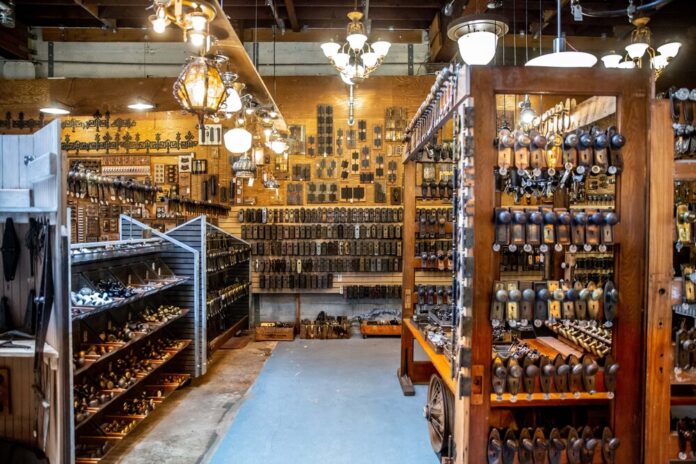
Embarking on the path of antique authentication, having an exemplar at hand—a piece whose authenticity remains unquestioned—serves as a beacon. When placed side by side, the item under scrutiny and this exemplar, even the slightest inconsistencies or resemblances in design intricacies, material textures, or patterns of wear and aging, become discernible.
Such detailed comparisons can act as the litmus test, determining the authenticity of a piece, highlighting disparities or affirming similarities, thus paving the way towards conclusive identification.
Consulting Experts and Appraisers
Navigating the vast expanse of antique hardware can be a daunting endeavor, even for the most seasoned collectors or enthusiasts. Occasionally, the waters turn murky, the path becomes unclear, and uncertainty prevails.
In such intricate situations, turning to the expertise of specialized appraisers or antique experts becomes not just beneficial, but essential. Armed with decades of experience, an unwavering eye for detail, and access to exhaustive reference materials, these seasoned professionals provide clarity.
They hold the capability to cut through prevailing doubts, delivering either solid validation or, at times, surprising insights that reshape perspectives.
Common Reproduction Techniques
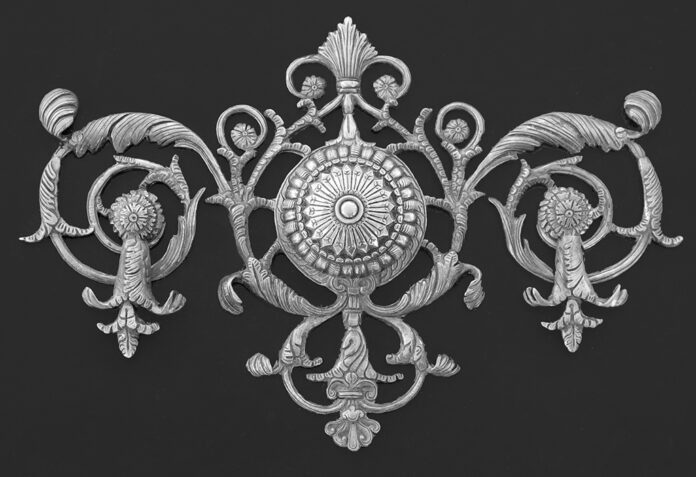
As we sail through the modern age, reproduction methodologies are evolving, growing ever more intricate and deceptive. A seasoned collector or enthusiast must remain ever-vigilant, acquainting themselves with contemporary imitation techniques.
This includes recognizing the touch of modern alloys alien to bygone eras or machine finishes too perfect for historical standards. A discerning eye will also spot artificially induced patinas, which, though designed to mimic the passage of time, often betray their true nature upon close inspection.
Conclusion and Resources
The odyssey of antique hardware authentication is rife with challenges, mysteries, and revelations. It’s a dance between past and present, art and science. To waltz gracefully through this dance, one needs a trove of knowledge, unwavering dedication to research, and the discernment of a hawk.
As seekers in this domain, equipping oneself with a repertoire of resources, be it enlightening literature, dedicated online platforms, or networks of seasoned experts, will ensure the journey is not just rewarding but also deeply enriching.










